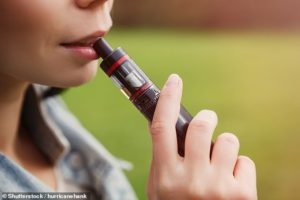“Vaping the Venom”
A case study has been published which explains the story of a young man who died of mouth cancer after extensive use of e-cigarettes.

From the Four corners Program 28 June 2022
The fighting fund
According to electoral records, the Liberal Party received sums of $20,000, $15,000, $7,000 and $2,000 from 33-year-old Sydney man Brian Marlow last financial year.
Mr Marlow is the director of Legalise Vaping Australia, which campaigns for the right to buy and sell nicotine-containing vapes. The organisation is an off-shoot of a libertarian activist group, the Australian Taxpayers’ Alliance.
Mr Marlow is also a friend of Liberal Senator Hollie Hughes, who is one of the Coalition’s fiercest advocates for vaping as a tool to quit cigarette smoking.
Senator Hughes says their friendship has nothing to do with her stance.
“Surprisingly, I’m actually able to make up my own mind on issues. This might come as a shock to some people, but there are women in the Liberal Party who have their own minds and are able to determine what they feel about an issue.”
Senator Hughes chaired a Senate committee inquiry into vaping in late 2020, in which she said that vaping was a form of “tobacco harm reduction” that had helped her go 60 days without a cigarette.
The senator’s comments about the effectiveness of vaping as a method to quit smoking are at odds with research published in a government-commissioned report and the latest findings of the National Health and Medical Research Council.
The $44,000 in donations was declared as coming from Mr Marlow personally: the disclosure forms make no mention of Legalise Vaping Australia or any vaping interests.
Having cancelled an interview with Four Corners, Mr Marlow responded in writing, revealing the true source of the donation was Legalise Vaping Australia.
In mid-2020, the organisation set up a “fighting fund” to oppose the changes to vaping regulations.
“After the former health minister [Greg Hunt] announced a ban on the importation of vaping products, with two weeks’ notice and zero consultation, vape shops across the country donated over $100,000 to our organisation in less than a week,” he said.
“Off the back of that, we held a series of vaping roundtable events to allow working-class vape shop employees and shop owners the chance to have long-form engagement with Members of Parliament.”
Mr Marlow said these roundtable meetings included one with Senator Hughes, who was pictured on Facebook with him, as well as vaping advocate Colin Mendelsohn, who is her prescribing doctor, and a number of vape shop owners.
Asked why he had declared the donations as coming from himself and not the Legalise Vaping Australia fighting fund, Mr Marlow said it had been simpler to do so.
“Trying to round up multiple shop owners, multiple employees, across multiple states and getting them to each individually pay for and book each roundtable ticket etc would have been too much work and akin to trying to herd cats,” he said.
“To make things easier, I paid for everything, which meant I was required to make the relevant declarations.”
Mr Marlow denied the source of the donations had been concealed. He declined to say which other politicians had attended roundtable meetings or explain in detail how the payments related to the events.
When Four Corners sought further clarification, Mr Marlow declined and said: “I really cannot be bothered wasting any more of my time trying to explain the bleeding obvious.
“Enjoy your smear campaign.”
Smoking and vaping are linked to COVID-19.
A recent Cochrane Review has been criticised,
“We strongly believe that both tobacco smoke and electronic cigarette condensates in the lungs are neither
healthy, nor safe. Coupled with the probability of long-term adverse health effects, this should be sufficient to
convert the opinion of fence-sitters, parliamentarian, and pro-vapers with a conscience. Great caution should
also be taken by policymakers when promoting such products. We do not believe that substantial evidence
exists for electronic cigarettes to be used as a tool for smoking cessation. In our opinion, the risks of
electronic cigarettes are far too great for them to be deemed safe to be prescribed by medical professionals.”
McAlinden KD, Barnsley K, Weber HC, et al. Cochrane review update leaves big
questions unanswered regarding vaping: implications for medical practitioners. Eur Respir J 2021; 57:
2100022 [https://doi.org/10.1183/13993003.00022-2021].Cochrane review update leaves big questions unanswered regarding vaping Implications for medical practitioners McAlinden Barnsley et al May 2021
The New York Times has published an article on smoking, vaping and COVID-19.
Australian health websites recommend against smoking or vaping.
It’s more likely than not that people who smoke or vape have a higher risk of getting coronavirus (COVID-19), compared to people who don’t smoke or vape. This is based on the knowledge that people who smoke or vape are at a higher risk of getting many other lung and chest infections.
Also, the hand-to-mouth action of smoking and vaping means that people who smoke or vape may be more vulnerable to infection, as they are touching their face and mouth more often.
In addition, sharing any type of tobacco product (cigarettes, e-cigarettes or shisha/waterpipes) can increase the risk of spreading coronavirus.
There is a small risk that the aerosol coming from an e-cigarette device can also spread coronavirus if the aerosol is inhaled or if it settles on a surface that someone subsequently touches.

Using e-cigarettes triples the chance of a non-smoker taking up cigarettes and there is “insufficient” evidence that they help smokers quit, according to a new report submitted to the Government.
Research led by The Australian National University (ANU) reviewed the worldwide evidence on e-cigarettes and smoking behaviour, relevant to the Australian context.
“We found clear evidence that non-smokers who use e-cigarettes are around three times as likely to take up conventional smoking as their peers who don’t use e-cigarettes,” lead researcher Professor Emily Banks from ANU said.
The study was undertaken with researchers from the University of Melbourne.
“Our findings support concerns that e-cigarettes are a gateway to smoking, especially among young people,” University of Melbourne researcher Olivia Baenziger said.
The researchers say Australia “leads the world in tobacco control”, with 11 per cent of adults smoking daily and younger generations driving the trend down with around 97 per cent of 14- to 17-year-olds having never smoked.
“E-cigarettes could undermine a wonderful smoke-free start in life,” Professor Banks said.
Young women are being targetted by e-cigarette companies.

A new study has suggested that vaping ‘could increase the risk of breast cancer’
Scientists from a group of American universities, including Yale, Johns Hopkins and Princeton have found exposure to e-cigarette vapour creates a “tumour-promoting environment” in the breast and elsewhere in the body.
A surgeon at the London Breast Institute at the Princess Grace Hospital named Professor Kefah Mokbel warned the findings should be a wake-up call to those who think the devices are harmless, or better than smoking normal cigarettes.
“This study provides a good level of evidence that vaping has the potential to induce breast cancer and promote its progression and spread to the lungs,” he said.
He went on to add that it is a “misconception” that e-cigarettes are safe and believes that vaping could prompt the development of other types of cancer.
Big Tobacco’s Relentless Vape Campaign
ACOSH · OCT 26, 2022 · Tobacco Industry Observatory
Big Tobacco is spending millions of dollars on a relentless campaign in Australia to get vaping legalised so that these addictive products can be sold from every street corner shop as an ordinary consumer item.
Disturbingly, an epidemic of e-cigarette use by children, teenagers and young adults in Australia has the potential to undermine the past 40 years of successful tobacco control activities.
It is sometimes not obvious that Big Tobacco is orchestrating this campaign behind the scenes by providing money and other forms of support to professional lobbyists and front organisations with clear conflicts of commercial interest.
The accompanying articles describe and reveal the methods being used by Big Tobacco to get vaping across the line and have been published by a variety of respected media platforms:
- The secret money trail behind vaping, Feb 20, 2021
- Australian Retailers Association cancels secret tobacco contract, Feb 20, 2021
- More vaping lobbyists linked to Big Tobacco, Feb 22, 2021
- Metadata reveals medical charity ATHRA received assistance from PR company linked to vaping campaign, Mar 26, 2021
- Still plenty of smoke in the vaping wars, Jun 2, 2021
- Vapers’ facelift: new pitch, same sponsors Jun 28, 2022
- Retail lobby group chief quits but vaping push continues, Jul 15, 2022
- Health Department, TGA launch legal action against online vape store, Jul 27, 2022
- Vaping details? They’re lost in the cloud, Aug 2, 2022
- National Retailers Association chief Dominique Lamb to resign as questions rise over tobacco lobby, Sep 1, 2022
Government legislation has passed both houses.
Legislation to ban the sale of e-cigarettes to children, and to vape in public places where smoking is banned, is now law in Tasmania. The display restrictions are the same as for tobacco.
A young woman in Sydney has been hospitalised after vaping. October 2021
Dakota’s doctors thought she might have COVID, but it was vaping that put her in ICU
By the Specialist Reporting Team’s Alison Branley and national medical reporter Sophie Scott
New Evidence on E-cigarettes
Breast cancer and lung cancer progression
“Our findings, for the first time, showed that E-cig promotes BC [breast cancer] growth and metastasis. This study highlights the critical role of TAMs [tumor-associated macrophages] via CCL5 and VCAM-1 pathways in E-cig promoted BC tumor development.”
E-cigarette promotes breast carcinoma progression and lung metastasis: Macrophage-tumor cells crosstalk and the role of CCL5 and VCAM-1 Cancer Letters Volume 491, 28 October 2020, Pages 132-145
Kien Pham, Do Huynh, Le Le, Daniel Delitto, Lei Yang, Jing Huang, Yibin Kang, Michael B Steinberg, Jieliang Li, Lanjing Zhang, Dongfang Liu, Moon-Shong Tang, Chen Liu, He Wang
Mental health problems associated with vaping
“Youth EC [e-cigarette] use is associated with greater mental health problems (compared to non-use) across several domains, particularly among adolescents. “
Systematic review of electronic cigarette use (vaping) and mental health comorbidity among adolescents and young adults, Nicotine & Tobacco Research, Timothy D Becker, Melanie K Arnold, Vicky Ro, Lily Martin, Timothy R Rice
In the report Public Health Consequences of E-Cigarettes,
……an expert committee of the National Academies of Sciences, Engineering, and Medicine presents 47 conclusions related to outcomes of e-cigarettes, including their key constituents, human health effects, initiation and cessation of combustible tobacco cigarette use, and harm reduction.
The conclusions below are organized by level of evidence (with each level of evidence defined on page 2).
To see the conclusions organized by outcomes and to read the full report and related resources, please visit and also here.
E-cigarettes should be banned
SmokeFree Tasmania made a submission to the government in 2015. See SFT ENDs submission 2015 . You can see the submission from the Tasmanian Heart Foundation and Cancer Council here Heart_Foundation_Cancer_Council_Submission_to_E-cig_RIS27Jan2017.
The government released a regulatory impact statement on e-cigarettes – January 2017. SFT has made it clear that we consider that the sale of all e-cigarettes should be banned. See ABC Report and Examiner story.

Youth uptake
Children more likely to use e-cigarettes than to smoke other tobacco products – UK study in Wales. And others (Miech et al) say it is a bridge to smoking. “These results contribute to the growing body of evidence supporting vaping as a one-way bridge to cigarette smoking among youth. Vaping as a risk factor for future smoking is a strong, scientifically-based rationale for restricting youth access to e-cigarettes.”
E-cigarettes are more likely to encourage adolescents who would normally be low risk for smoking, to vape. This 2016 study in Pediatrics found “Several reasons for first trying e-cigarettes predicted continued use, including low cost, the ability to use e-cigarettes anywhere, and to quit smoking regular cigarettes. Trying e-cigarettes because of low cost also predicted more days of e-cigarette use at wave 2. Being younger or a current smoker of traditional cigarettes also predicted continued use and more frequent use over time.”
Misleading and deceptive conduct by e-cigarette companies in Australia
The ACCC lodged a case in June 2016 in the Federal court two e-cigarette companies in Australia for misleading consumers. The ACCC said its testing showed formaldehyde and acetaldehyde were present in both brands of e-cigarettes, among other toxins. Formaldehyde is classified by the World Health Organisation International Agency for Cancer Research as a Group 1A carcinogen, meaning there is sufficient evidence to show it is carcinogenic to humans. Acetaldehyde is classified as a Group 2B carcinogen by the IARC, which is classified as being possibly carcinogenic to humans. And also in September 2016 against another e-cigarette company.
Learn about e-cigarettes in this rather long lecture from Stant Glantz. Make a cup of tea, sit down and watch this. https://tobacco.ucsf.edu/stan-glantz-lecture-ecigs-available-online
Myths that failed to impress Australian regulators.
Prof. Simon Chapman says “..unlike antibiotics, which are heavily regulated, require a prescription, and must demonstrate both safety and efficacy to regulatory bodies, e-cigarettes and the liquids used in them are virtually unregulated.”
The claim that e-cigarettes are “95% safer” has been debunked by Professor Chapman.
More on Health effects
A statement from the AMA in September 2015.
“There has been a lot of debate about whether electronic cigarettes are the best technological solution to the smoking pandemic or the biggest looming threat to public health.
E-cigarettes are battery-powered devices that deliver nicotine to the user through a vapour by heating a solution of propylene glycol or vegetable glycerin, flavouring, and other additives. Flavours range from butter rum to caramel macchiato to strawberry lemonade.
The US Centre for Disease Control and Prevention reported earlier this year that the use of e-cigarette devices among middle school and high school students tripled between 2013-2014, with around 13 per cent of students using the devices. This surpasses the number of teens who smoke conventional cigarettes in the US.
Currently, there are more than 500 e-cigarette brands and more than 7000 flavours, and they all work in different ways to deliver varying amounts of nicotine, toxins, and carcinogens. With most e-cigarette studies funded or otherwise supported, influenced by manufactures of e-cigarettes, the current evidence base on e-cigarettes is very poor.
Julia Belluz from Vox recently examined more than 60 articles, studies, and reviews, and interviewed nine researchers and health experts to try and determine whether e-cigarettes were actually safe. You can read her detailed findings at.http://www.vox.com/2015/6/26/8832337/e-cigarette-health-fda-smoking-safety“
E-cigarettes or Electronic Nicotine Devices (ENDS) are not legal in Australia. Non nicotine devices “vapeing” are legal, and regulated in some states but not Tasmania.
The Tasmanian Government has released a Discussion Paper on ENDS.
Official federal government TGA statements March 2015 and February 2017.
The Cancer Council and the Heart Foundation both have position statements on e cigarettes.
The political parties appear to have similar views.
In the USA , where nicotine based e-cigarettes are legal, as in many European countries, there is evidence that teen use of e-cigarettes has skyrocketed and that e-cigarette marketing continues to mimic tobacco advertising of the bad old days, with a youth focus.
There are differing views internationally about e-cigarettes and this article by Amy Fairchild et al canvasses some of the arguments.
There is danger of nicotine capsules for children. Liquid nicotine used in electronic cigarette devices is highly concentrated, unreliably packaged, and poorly regulated. There is also the problem of injury from exploding e-cigarettes. These explosions have been observed frequently enough that the US Department of Transportation has recently banned E-cigarette devices in checked baggage aboard airplanes.
Matt Myers (USA) interview – Tobacco Free Kids.